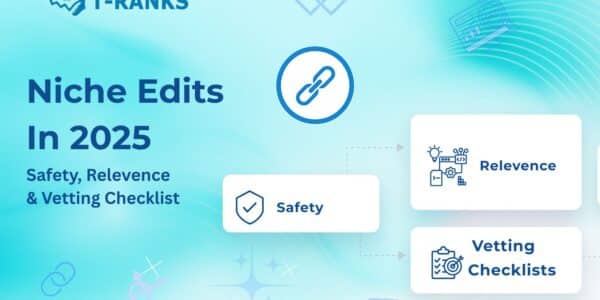Have you ever searched for something like “best PBN link providers” and noticed dozens of websites already ranking on Google for that keyword?
Now imagine instead of pitching those sites for a guest post, you simply ask them to add your link inside one of their existing articles that’s already ranking.
That’s called a niche edit a smart, modern link-building approach where you get placement on an established page instead of starting from scratch.
Because the article is already published and indexed, your link starts working immediately.
You don’t wait weeks for Google to crawl a new guest post. You tap into a page that already has traffic, authority, and trust.
In this guide, you’ll learn how niche edits actually work, why they deliver faster results than traditional guest posts, and how to use them safely in 2026.
We’ll break down:
- What makes a niche edit different from other link types
- How to vet placements for safety and real SEO value
- How Google’s AI-driven algorithms read contextual links
- And how to track performance to build lasting authority
By the end, you’ll know how to use niche edits to build stronger rankings, faster, while staying fully compliant with modern link guidelines.
What Are Niche Edits?

A niche edit is a backlink inserted into an existing, aged article that’s already indexed and trusted by search engines. Instead of publishing new content, your link is placed inside a live page that already ranks for relevant topics. This allows your website to instantly share in that page’s authority and relevance.
These edits are also called contextual link insertions because they blend naturally into sentences that already make sense to readers. When done properly, they act as genuine editorial citations not forced backlinks which makes them both effective and safe for SEO. This same principle of contextual relevance is also central to building PBN link juice that strengthens a site’s topical authority.
Example: A fitness brand could place a link to its Smart Treadmill Guide inside an article titled Top Home Workouts. Because the article already ranks and has topical relevance, the link passes contextual authority and helps the target page rank faster.
How Niche Edits Work
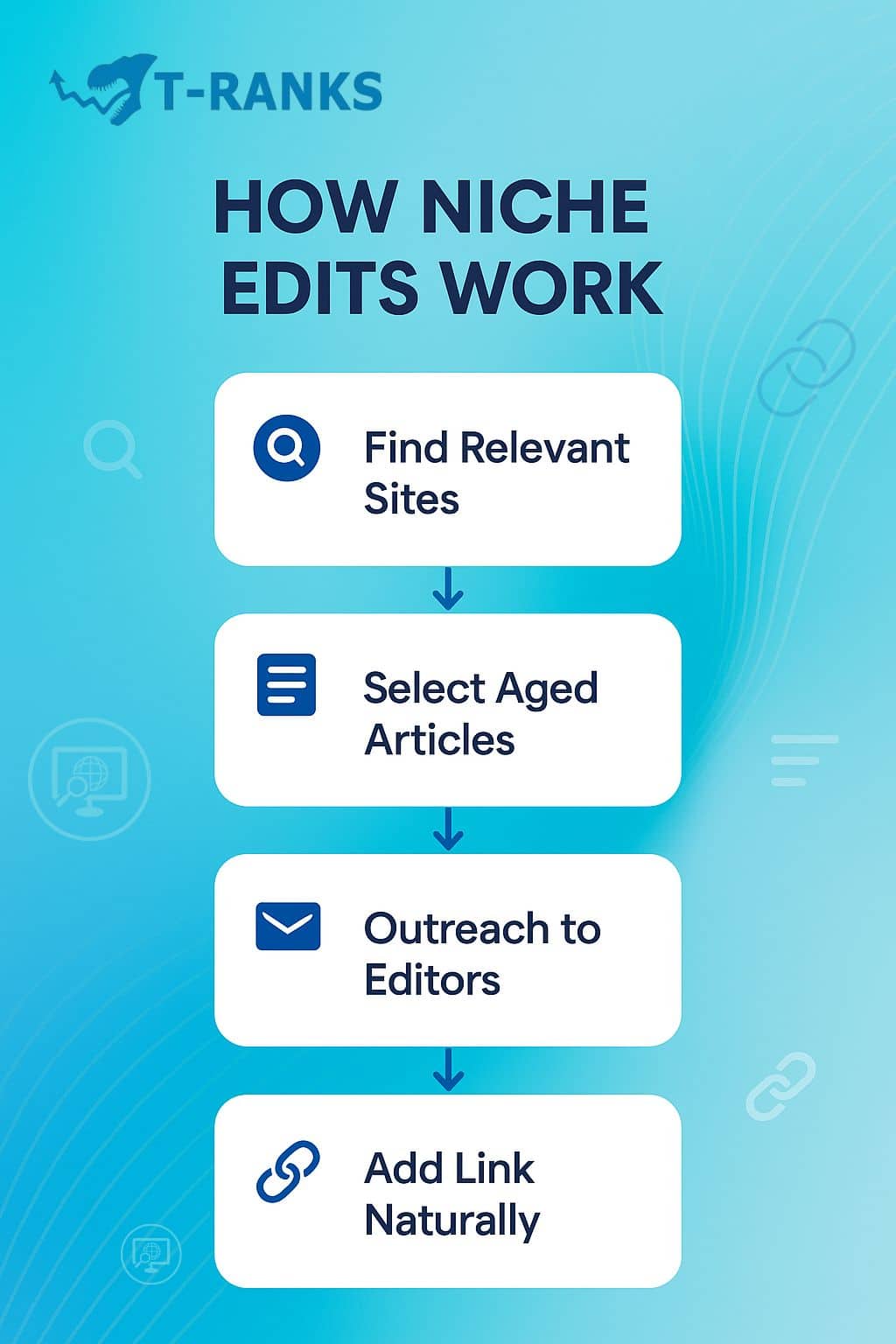
Niche edits follow a structured four-step process designed to keep placements natural, relevant, and compliant with Google’s linking guidelines:
- Find Relevant Sites – Use tools such as Ahrefs or Semrush to identify websites with real organic traffic in your niche. Focus on those with aged domains and consistent topical publishing.
- Select Aged Articles – Choose posts that already cover similar subjects and rank for related keywords. Pages with long-term indexing tend to pass stronger authority.
- Outreach Strategically – Contact the editor or site owner and explain how your link improves the article — for example, by adding new data, citing fresh research, or replacing outdated resources.
- Add the Link Naturally – Place your link within a paragraph where it fits contextually. Use descriptive anchor text and apply rel=”sponsored” for paid placements or dofollow for earned editorial links.
This approach ensures your links read naturally to humans and algorithms alike, preserving editorial integrity while enhancing topical connections.
Why Niche Edits Work
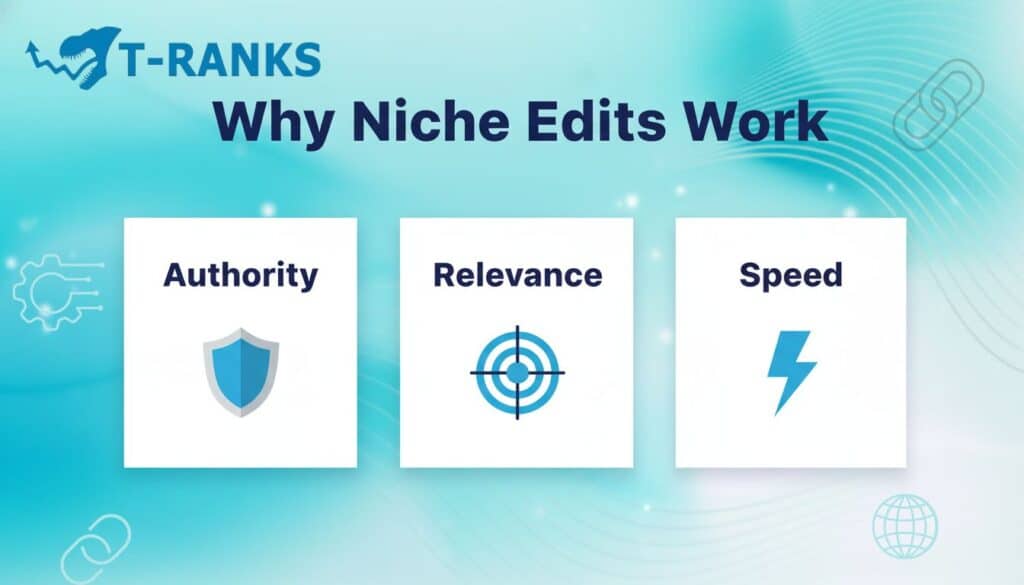
Niche edits perform well because they combine authority, relevance, and speed — the three qualities Google values most in modern link signals.
- Authority Transfer: You inherit link equity from a trusted, aged page that already has backlinks and search visibility.
- Relevance Match: The link appears inside a paragraph that directly relates to your topic, reinforcing contextual meaning for both users and search engines.
- Faster Results: Since the host page is already indexed, your backlink is discovered and valued faster, leading to quicker ranking gains.
Unlike new guest posts that take time to crawl and index, niche edits begin influencing search visibility almost immediately.
Types of Niche Edits

| Type | Description | Risk Level |
| White-Hat | Manual outreach or fixing unlinked brand mentions on relevant sites. | Safe |
| Gray-Hat | Paid placements using rel=”sponsored” with clear disclosure. | Moderate |
| Black-Hat | Links inserted into hacked or spam-driven domains. | High |
A sustainable SEO strategy should always prioritize white-hat or transparently disclosed gray-hat placements. Ethical linking protects your site from penalties and maintains a clean backlink graph.
Guest Posts vs. Niche Edits: Key Differences (2026 Update)

Both guest posts and niche edits are proven link-building methods, but they serve different goals in an SEO strategy. Guest posts build brand authority through original, authored content, while niche edits deliver faster SEO results by placing contextual links inside trusted, aged articles already indexed on Google.
Guest posts strengthen credibility and demonstrate expertise, helping your site build long-term E-E-A-T (Experience, Expertise, Authoritativeness, Trustworthiness). Niche edits, meanwhile, offer quick visibility by tapping into existing authority pages.
A balanced SEO plan combines both guest posts for trust and exposure, niche edits for speed and contextual relevance. This mix aligns with the diversified approach outlined in PBN Links vs Guest Posts – Strategies & Examples and ensures a natural backlink graph recognized by Google’s SpamBrain system.
Feature Comparison
| Feature | Niche Edits | Guest Posts |
| Effort | Low – uses existing content; only contextual insertion required. | High – needs full article creation, review, and publishing. |
| Speed | Fast – page is already indexed and carries link equity. | Slow – new post requires crawling and ranking time. |
| Control | Limited – must blend within the host page’s context. | Full – you control the message, structure, and keyword use. |
| Cost | Lower – no writing fees, only placement cost. | Higher – covers writing and editorial placement fees. |
| Visibility | Subtle link within existing content. | Full author credit, bio, and exposure to new readers. |
| Safety | Safe when placed manually on relevant, editorial sites. | Safe on reputable websites with editorial oversight. |
| Longevity | Dependent on the host page’s lifespan and index status. | Long-term asset that remains visible indefinitely. |
When to Use Each
Choose Niche Edits When:
- You need quick SEO gains without waiting for new pages to rank.
- You’re reinforcing topical clusters and semantic relationships.
- You’re scaling backlinks efficiently while maintaining context.
- You want to complement existing PBN link strategies for steady authority flow.
Choose Guest Posts When:
- You’re building brand authority and showcasing expertise through original writing.
- You want full creative control over tone and target keywords.
- You’re launching or rebranding and need strong visibility.
- You’re targeting authoritative sites for referral traffic and audience trust.
Pro Tip: Blend both link types — guest posts for credibility, niche edits for momentum. This combination creates a balanced backlink profile that boosts rankings faster and sustains them longer
Why Contextual Links Matter for SEO
Contextual links are backlinks placed within relevant, topic-aligned content that help search engines understand how your page connects to a subject. They appear naturally inside paragraphs, reinforcing meaning and trust rather than sitting in sidebars or footers.
Search engines like Google now evaluate where and how a link appears, not just how many exist. A contextual link surrounded by semantically related text provides stronger signals of authority, helping your page rank for precise topics and queries.
How Context Strengthens SEO
Contextual placement allows a backlink to act as a semantic bridge between your content and authoritative sources. When a link appears within a paragraph discussing similar entities or terms, Google’s algorithms interpret it as genuine topical relevance. This process supports entity recognition — the same principle used when building topical authority maps that cluster related pages together.
For example, linking an article about SEO audits to another discussing technical site health helps both pages signal thematic consistency. According to Google’s Link Best Practices, such relevance-driven connections improve indexing efficiency and content trustworthiness.
Why Contextual Links Outperform Generic Links
- Better Authority Flow: Contextual links pass more value because they sit inside meaningful text on trusted, indexed pages.
- Improved User Experience: Readers are more likely to click links that add context or detail, increasing engagement and reducing bounce rates.
- Entity Alignment: AI systems like Google’s AEO and Perplexity analyze surrounding words to evaluate topic alignment. When your backlink sits near semantically related phrases or brand mentions, it reinforces your position within that entity network.
- Faster Crawling: Links inside content that’s regularly updated are crawled sooner, speeding up how quickly new pages gain visibility.
Real-World SEO Impact
Contextual backlinks are particularly effective when combined with diversified link sources such as guest posting or niche edits. Unlike isolated links, contextual placements feed into Google’s knowledge graph, making it easier for AI models to associate your website with credible topics and brands. This improves your site’s ability to appear not only in SERPs but also in AI summaries and rich snippets a key visibility factor for 2026.
Pro Tip: Prioritize one high-quality contextual link over several low-value backlinks. A single placement inside a trusted, topically relevant article can outperform dozens of sidebar or footer links in both ranking power and long-term stability.
How LLM-Based Rankings Value Semantic Context
Large Language Models (LLMs) like Google’s AI Overviews, Perplexity, and ChatGPT evaluate backlinks based on semantic context rather than raw quantity. They focus on meaning how the words surrounding a link align with your page’s topic, intent, and entities. This shift means a single well-placed link within relevant text can outweigh dozens of off-topic backlinks.
From Link Quantity to Semantic Quality
Older SEO models rewarded link volume. Modern ranking systems powered by LLMs analyze language patterns, topic proximity, and entity relationships to judge link relevance. When a backlink sits inside text that naturally mentions related terms or brands, it becomes a verified semantic signal.
For example, a link to a CRM automation guide placed within a paragraph mentioning HubSpot or Salesforce tells Google’s AI that your page belongs to the same topical ecosystem. This type of co-citation helps your content qualify for contextual visibility in AI-generated answers — not just traditional search results.
LLMs assess these relationships using similar techniques found in semantic link-building strategies, where emphasis lies on relevance, topical clusters, and entity alignment.
Why Semantic Context Drives Modern Rankings
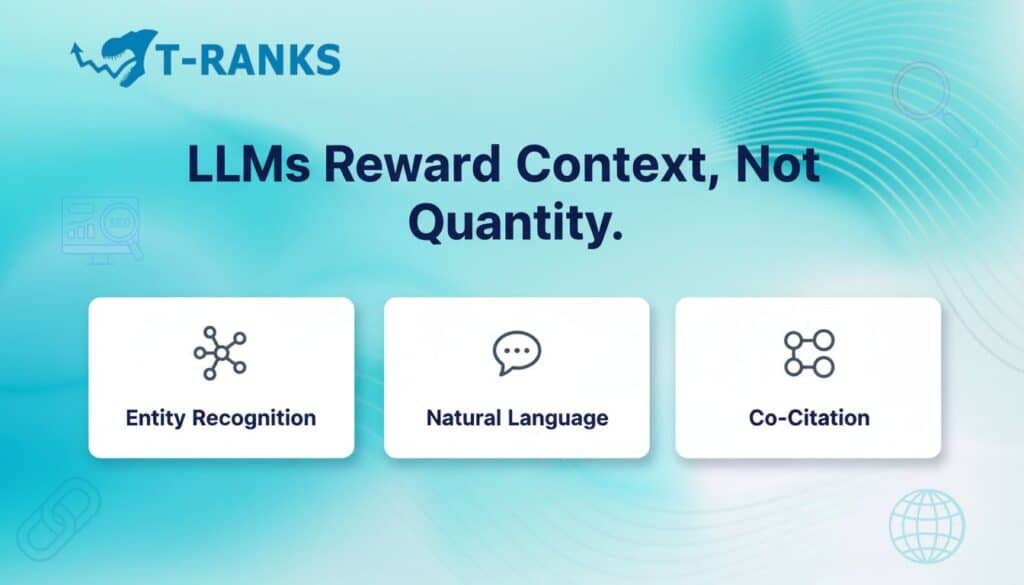
- Entity Recognition: LLMs map out how your brand or page relates to others through shared entities, keywords, and references. A link near thematically aligned text strengthens your topical identity.
- Natural Language Validation: Algorithms interpret link intent through phrasing and tone. Links that appear conversationally inside coherent sentences are rewarded more than keyword-stuffed anchors.
- Reduced Dependence on DR/DA: Traditional metrics like Domain Rating still matter, but AI systems weigh semantic trust more heavily — rewarding smaller, context-rich sites over large but irrelevant ones.
- Citation Propagation: When your link appears near authoritative mentions, it can trigger co-citation across AI summaries and related query answers, expanding your reach beyond SERPs.
Practical SEO Application
For SEOs, this means optimizing for topic clarity, not just metrics. Each backlink should support your site’s entity map by linking from semantically consistent content. When you combine LLM-aware niche edits with PBN link juice strategies, you create a link ecosystem that both algorithms and AI crawlers can interpret confidently.
Pro Tip: LLMs reward context depth, not keyword repetition. Ensure every backlink adds narrative value to its paragraph — if it feels natural to a reader, it’s also clear to AI.
How We Vet Safe Niche Edits (T-RANKS Layered Model)
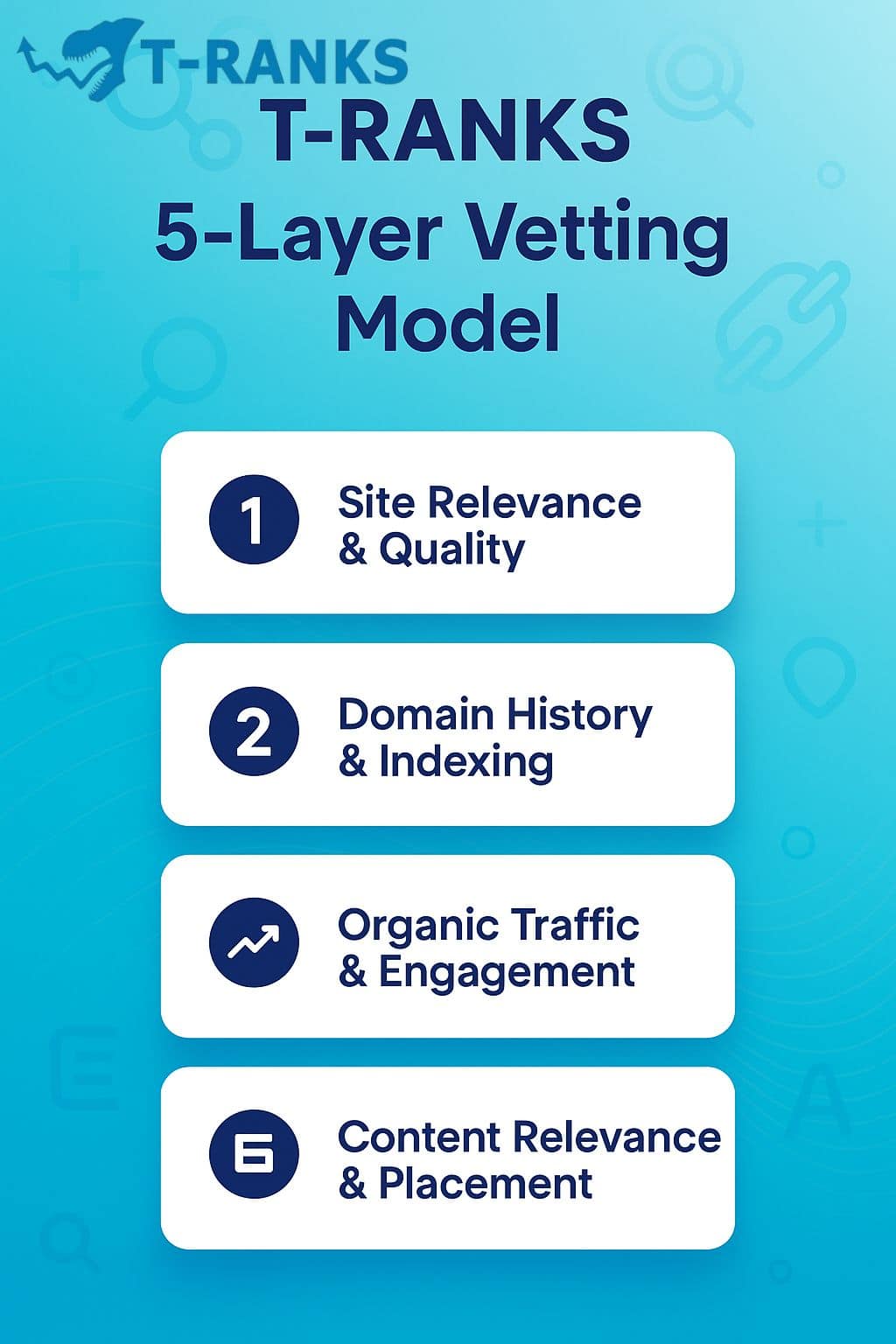
At T-RANKS, every niche edit goes through a five-layer vetting process that ensures safety, contextual relevance, and long-term SEO performance. This model builds on Koray Tuğberk Gübür’s concept of layered validation . In this model we combine data, editorial analysis, and entity checks to protect your backlink profile from Google’s algorithmic and AI-based filters.
Unlike automated vendors, we use a manual, evidence-driven workflow that prioritizes real traffic, topical consistency, and natural link placement. Each step connects to your site’s broader authority strategy, supporting topical clusters and sustainable rankings.
Step 1 – Check Site Relevance and Quality
The process starts with verifying topical alignment. We identify websites that consistently publish content within your niche and maintain a stable editorial focus. If a site covers unrelated topics or shifts industries frequently, it fails our relevance filter.
Our analysts review E-E-A-T signals, publication cadence, and content tone. We look for trusted domains similar to those used in advanced link-building techniques for tough niches sites that demonstrate topical authority and real user engagement.
Goal: Ensure every backlink originates from a domain whose audience and content align with your business theme.
Step 2 – Review Domain History and Indexing
Next, we analyze the domain’s historical footprint. Using tools like Archive.org and Whois data, we confirm long-term ownership stability and consistent topical focus. Aged domains that have retained their identity and clean indexing pass this stage; repurposed or de-indexed domains do not.
Stable indexation proves trustworthiness — a critical factor in maintaining PBN safety and footprint prevention for our network partners and client placements alike.
Step 3 – Evaluate Organic Traffic and Engagement
We use Ahrefs and Semrush to verify that each host site receives steady, relevant traffic. Healthy traffic trends, keyword diversity, and engagement signals (comments, shares, or backlinks) show that a site is active and valued by readers.
Any sudden traffic drops or unnatural keyword spikes trigger a deeper audit before approval. This ensures that every link passes value from a living ecosystem not a dormant or penalized domain.
Step 4 – Verify Content Relevance and Placement
Before inserting a link, we manually review the article itself. The link must sit inside a paragraph that naturally connects to your topic and improves user understanding. We never use sidebars, footers, or generic lists.
Each placement is crafted for contextual resonance — the same principle behind our internal link-juicer optimization framework. By ensuring thematic alignment at the paragraph level, we preserve editorial integrity and enhance the semantic weight of each backlink.
Step 5 – Keep Anchors and Attributes Clean
Finally, we validate anchor text and link attributes. Anchors must sound natural within the sentence and describe the target page accurately. We avoid over-optimized keywords, repetitive phrasing, or forced brand mentions.
If a placement is paid, it’s marked with rel=”sponsored”. Earned editorial links remain dofollow but always fit the surrounding context. This transparency keeps your backlink profile clean, compliant, and resilient against Google’s SpamBrain and manual reviews.

Why This Layered Model Works
Each layer supports the next from niche alignment to link placement — forming a closed-loop system of quality assurance. This process helps T-RANKS deliver backlinks that stay indexed, transfer consistent link equity, and reinforce your site’s entity relationships across Google’s knowledge graph.
In practice, it means your links don’t just look safe; they perform safely. They strengthen authority signals, resist devaluation, and maintain visibility even through major algorithm updates.
Pro Tip: Never rely on automation alone. Manual vetting with contextual validation remains the only proven way to build links that AI systems and search evaluators both trust.
Safe vs. Unsafe Niche Edits
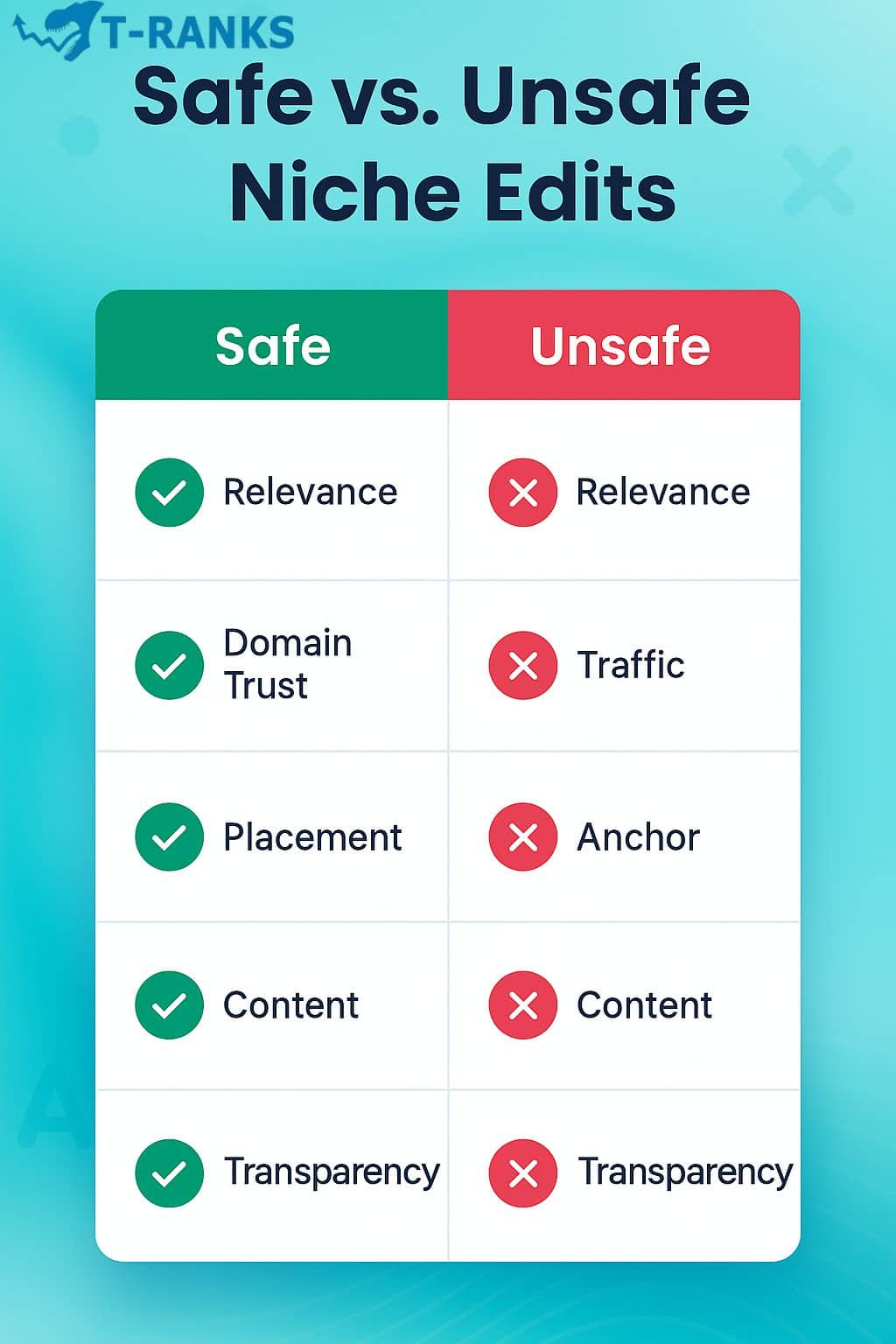
Safe and unsafe niche edits may look similar on the surface, but they operate on completely different principles.
A safe niche edit strengthens authority by appearing on real, high-quality websites with organic traffic and genuine editorial control.
An unsafe niche edit, however, is often inserted through shortcuts — such as hacked pages, repurposed domains, or spam-driven networks — that can quietly harm your SEO instead of helping it.
At T-RANKS, we classify every placement according to three non-negotiable standards: editorial quality, topical relevance, and compliance with Google’s link policies.
The real difference lies in how a link is acquired, where it is placed, and whether the surrounding content aligns with your niche.
When these conditions are met, niche edits build long-term trust; when ignored, they invite penalties and link decay.
Key Comparison
| Criteria | Safe Niche Edit | Unsafe Niche Edit |
| Relevance | Placed on articles that closely match your topic or intent. | Added to off-topic or low-quality pages with no thematic connection. |
| Domain Trust | Hosted on established sites with a consistent history and visible authors. | Placed on repurposed, expired, or anonymous domains. |
| Traffic Quality | Steady organic visits from relevant regions and keywords. | Fake or volatile traffic from unrelated geographies or bots. |
| Placement | Inserted within a contextual paragraph that adds value. | Dropped into footers, bios, or unrelated lists. |
| Anchor Text | Natural wording that fits the sentence; attributes used correctly. | Keyword-stuffed or misleading anchors marked as dofollow when paid. |
| Content Quality | Human-written, topic-aligned content with recent updates. | Spun or AI-generated text created solely for selling links. |
| Transparency | Visible publisher information and editorial policies. | Hidden ownership or fake author profiles with no accountability. |
How to Identify Safe Placements
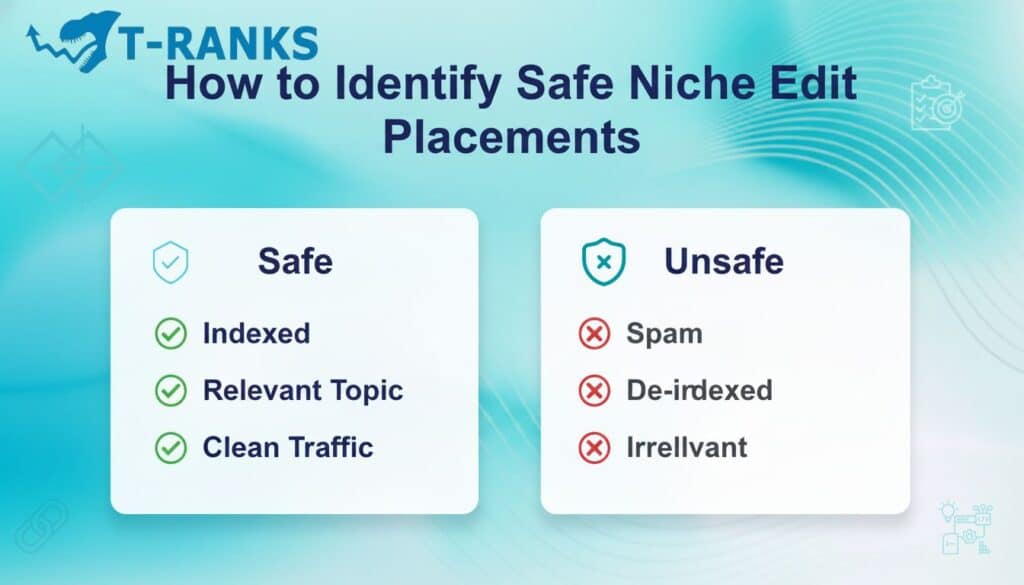
Before securing a link, review the host page’s indexing, content freshness, and outbound link behavior. Websites that publish in your niche regularly and maintain editorial standards tend to be safe. If a domain links to dozens of unrelated sites or has erratic traffic trends, treat it as a red flag.
At T-RANKS, our vetting system filters out risky publishers by combining manual reviews with data signals such as topical alignment, anchor diversity, and live-index checks. This ensures each niche edit aligns with your brand’s authority map similar to the structured auditing principles used in anchor text optimization best practices.
Why It Matters
Even a single unsafe niche edit can affect your backlink graph, pulling down overall trust flow and visibility. Safe placements, however, create a ripple effect improving entity consistency, topical depth, and referral traffic over time. That’s why we focus on editorial value first, not link quantity.ch
Pro Tip: If a link offer looks too cheap or promises instant rankings, it’s usually unsafe. Always choose relevance, authenticity, and context over speed.
How to Manually Vet a Niche Edit (Step by Step)
Vetting a niche edit is about more than checking metrics ,it’s about judging whether the link truly belongs in the article. A well-placed edit strengthens your topical authority, while a careless one can undo months of SEO work. Here’s a simple, practical way to review niche edits before approving or purchasing them.
Step 1 – Start With the Domain, Not the Link
Always begin by checking where the link lives. Open the website and ask: Does this site regularly publish in my niche? Look for genuine articles written by real authors, a visible contact page, and organic traffic that comes from relevant keywords. If the site covers ten unrelated industries, skip it — that’s usually a sign of link selling.
A healthy domain should have consistent updates, stable indexing, and an editorial focus that matches your content theme.
Step 2 – Check If the Page Is Indexed and Active
Before agreeing to a placement, copy the article URL and search it on Google using: site:example.com/article-title If it doesn’t appear, the page isn’t indexed, and the link will pass no value. Also, make sure the article isn’t too old or abandoned. Freshly updated content signals to Google that the page is still relevant, and your link will get crawled faster.
Step 3 – Read the Article Carefully
Never rely only on metrics. Read the full piece to see whether your link makes sense there. Would you, as a reader, click it? If the link feels forced, placed mid-sentence without context, or breaks the flow, it’s likely a poor-quality edit.
The best placements happen where your link adds something new like updated data, a tool reference, or an example that improves the reader’s understanding. That’s exactly how editorial link placements work — they contribute context, not clutter.
Step 4 – Review Traffic and Outbound Link Behavior
Use Ahrefs or Semrush to check the site’s organic traffic trend. Look for consistent growth and keyword diversity. If the traffic graph shows sharp drops or sudden spikes, the domain may have faced penalties or used manipulative tactics.
Also, scroll through other pages to see where they link out. If you find irrelevant outbound links (like casino or pharma), it’s safer to walk away. Quality sites rarely mix unrelated links in the same content cluster.
Step 5 – Analyze Anchor Text and Placement Style
Good anchors read naturally and help readers understand what’s being linked. Avoid edits that use exact-match keywords or awkward phrasing. A clean, descriptive anchor — like “SEO audit guide” or “content relevance checklist” — fits the sentence naturally and looks editorial.
Always double-check link attributes. Sponsored or guest edits should include rel=”sponsored”, while genuine contextual placements can remain dofollow. The key is transparency and natural integration.
Step 6 – Ask for Proof Before You Approve
Before finalizing, request a live preview or screenshot of the placement. Verify that it’s inside the article’s main content, not in a sidebar or author box. Legitimate editors will always share confirmation before publishing — link resellers often won’t.
Pro Tip: If a niche edit requires more justification than it provides value, it’s not worth it. Trust your instinct — relevant, human-placed links feel right when you read them.
PPR Scoring Example & Evaluation Logic
PPR stands for Prominence, Popularity, and Relevance — three signals used to judge the real value of a niche edit. Think of it as a quick health score that helps decide whether a placement is worth it or not.
- Prominence shows how visible and active the page is. If the article ranks for keywords or gets organic clicks, it has strong prominence.
- Popularity measures how many people engage with or link to that page. A site with steady backlinks, social shares, or referral traffic scores higher here.
- Relevance checks how closely the content matches your topic. This is the most important factor — even a smaller site can pass powerful authority if it’s contextually on point.
Simple Example: Imagine two potential placements:
- A DA 70 general news site with a random link mention.
- A DA 35 marketing blog writing about SEO tools. The second one often performs better because Relevance outweighs raw authority.
Most high-quality niche edits land above 0.7 in overall PPR balance — meaning the page is relevant, has real traffic, and stays indexed. If any one factor (especially relevance) is missing, the edit usually fails to rank well or deliver long-term value.
Pro Tip: Always prioritize relevance over numbers. A lower-DA page in your niche will outperform a high-DA page outside it almost every time.
Post-Placement Quality Checklist (After Your Link Goes Live)
Every niche edit needs a quick follow-up once it’s published. Checking the placement right away prevents wasted effort and helps you confirm that the backlink is passing real value. Use this simple checklist to make sure each link stays indexed, relevant, and secure.
✅ 1. Verify Placement Accuracy
- Confirm that the correct URL and anchor text are used.
- Ensure the link appears within the article’s main content, not in a footer or author box.
- Open the page manually to confirm the link directs to the right destination.
🔍 2. Check Google Indexing
- Search the exact URL in Google using site:example.com/article-title.
- Make sure the article is still indexed and visible.
- If not, request re-indexing through Google Search Console or add light content updates to prompt crawling.
📈 3. Monitor Link Performance
- Track the backlink using tools like Ahrefs or Semrush.
- Watch keyword rankings for the target page over the next few weeks.
- Note any changes in anchor text or placement that the editor makes later.
🔗 4. Evaluate Authority Signals
- Review referring domain metrics such as DR, DA, or traffic trends.
- Focus on topical fit and traffic quality — not just numbers.
- Cross-check referring URLs for clean link neighborhoods, similar to the methods used in expired domain backlink audits.
🔄 5. Schedule Regular Audits
- Recheck each link every 30–60 days.
- Replace or update removed or deindexed links promptly.
- Keep a small spreadsheet with link URL, anchor, placement date, and index status for easier tracking.
Pro Tip: Links that stay live and indexed for 90+ days usually remain stable long term — those that drop quickly often came from weak or spam-prone domains.
How Many Niche Edits per Month?

There’s no fixed number of niche edits that works for every site — it depends on your authority level, competition, and current backlink profile.
What matters most is consistency, not volume. Adding too many links too fast can look unnatural, while too few might not create noticeable movement in rankings.
Think of niche edits as a steady signal to Google: each placement reinforces your site’s credibility and topical connections.
A good strategy starts with a baseline, measures the effect, then gradually scales.
If your site is new or recovering from an update, begin slow — just a few high-quality edits per month.
For established brands with steady traffic, you can increase the pace as long as the links stay relevant and diverse.
When combined with guest posts, internal linking, and aged domains, niche edits contribute to a balanced link ecosystem that supports long-term SEO growth.
Here is a simple guideline we follow:
- New Websites (0–6 months): 3 to 5 niche edits per month
Build trust slowly with relevant placements and branded mentions. - Growing Businesses (6–18 months): 10 to 25 niche edits per month
Strengthen authority, support your main content clusters, and keep growth consistent. - Established Brands (18+ months): 25 to 60 niche edits per month
Expand visibility, build topic coverage, and balance niche edits with guest posts and PR links.
These numbers are flexible and depend on many factors such as competition level, content volume, and keyword strategy. For example, a SaaS company in a competitive space might need more frequent link building than a local business serving a small area.
At T-RANKS, our strategy always starts with data. We study your website, industry, and competitors before setting realistic monthly goals that help you grow safely and steadily.
Key Takeaway:
Do not chase a fixed number. Focus on steady, high-quality niche edits that match your content growth and traffic trends. This balanced approach keeps your backlink profile natural and supports long-term SEO success.
Integrating Niche Edits with Topical Authority Maps
Building topical authority means showing search engines that your website covers a subject completely and consistently. One of the most effective ways to strengthen that signal is by using niche edits to connect your site with other trusted and relevant sources in your industry.
At T-RANKS, we integrate niche edits directly into each client’s topical map. This approach ensures that every backlink supports your site’s structure and builds lasting authority.
How Niche Edits Strengthen Topical Authority
A topical authority map organizes your website into main topics (pillar pages) and supporting articles (cluster pages).
When you connect niche edits to this structure, each link adds external trust to your core topics and reinforces their related subtopics.
For example, a fitness site with articles on home workouts and healthy eating can gain more trust when a niche edit from a respected health blog links to one of those pages.
Why This Strategy Works
Niche edits act as external confirmations of your topical expertise.
They tell search engines that other authoritative websites trust your content on specific subjects. This helps your site appear in more searches related to your topic and builds long-term credibility.
Instead of scattering backlinks across random pages, a focused strategy places niche edits where they make the most impact. You strengthen weaker content clusters and balance authority across your site naturally.
Simple Steps to Apply This Method
- Map Your Topics: List your main topics and their related supporting articles.
- Spot Weak Areas: Identify content clusters that need more visibility or backlinks.
- Find Relevant Hosts: Look for aged, indexed articles in your niche with real traffic.
- Secure Contextual Links: Place niche edits in paragraphs that match your topic naturally.
- Update Internal Links: After adding external links, connect related pages to improve authority flow.
How T-RANKS Puts It into Practice
At T-RANKS, we run detailed audits and competitor research to guide every placement. We analyze your site’s structure, content gaps, and authority signals before recommending the right mix of niche edits. Each placement is chosen to support your topical hierarchy and help your pages grow together as a unified authority network.
Key Takeaway
When used strategically, niche edits become more than backlinks. They connect your content structure with trusted sites, strengthen your topical authority, and position your brand as a reliable voice in your industry.
Essential Tools and Templates for Niche Edit Campaigns
Running a safe and successful niche edit campaign requires the right tools and organized templates. At T-RANKS, we rely on a focused set of SEO tools and workflow templates to help our team find quality sites, verify placement safety, and manage long-term performance. These resources make the entire process easier, faster, and fully compliant with Google’s link guidelines.
Recommended SEO Tools
Each of the following tools serves a specific role in the niche edit process. When used together, they help you identify trustworthy websites, confirm relevance, and track ongoing link performance.
| Tool | Purpose | How It Helps |
| Ahrefs | Backlink and traffic analysis | Check the host site’s top pages, organic traffic, and keyword rankings to ensure it has real authority. |
| Semrush | Competitor and keyword research | Compare backlink growth and identify relevant topics where your content needs external support. |
| Archive.org (Wayback Machine) | Domain history check | Review the site’s past content and ownership to confirm it has not been repurposed or used for spam. |
| WHOIS Lookup | Ownership tracking | Verify domain registration details and confirm consistent ownership over time. |
| Hunter.io / Snov.io | Outreach management | Find verified contact emails for editors and manage personalized outreach efficiently. |
| Screaming Frog | Link monitoring and audit | Track the placement location, check link attributes, and detect any future changes automatically. |
| Google Sheets or Looker Studio | Campaign tracking | Store vetting data, monitor live status, and visualize traffic or ranking improvements easily. |
These tools together form a simple system that supports every step of your campaign—from finding opportunities to ensuring the links stay active and compliant.
Templates That Simplify the Process
Templates are equally important because they bring structure to your campaign. At T-RANKS, we use three core templates that help our team stay consistent, transparent, and data-driven.
1. Vetting Checklist Template
This spreadsheet helps you record all site metrics before you place a link. It includes:
- Host URL and target URL
- Topical relevance score
- Organic traffic (from Ahrefs or Semrush)
- Domain history and index status
- Anchor type and paragraph context
- Outbound link count and link attribute
By reviewing these details before outreach, you can quickly eliminate low-quality or risky sites.
2. Outreach Email Template
A short, personalized email always performs better than bulk messages.
Example:
Subject: Quick update idea for your article on [Topic]
Hi [Name],
I read your post on [Subtopic] and really liked the section about [Specific Detail].
I wanted to suggest adding our [Guide/Study], which expands on this topic and provides updated data for your readers.
Here’s the link: [Your URL].
Would you consider including it?
Best,
[Your Name]
This kind of email focuses on improving the article rather than selling a link, which increases trust and approval rates.
3. Link Tracking Sheet
After placement, this template helps you monitor link health over time. It tracks:
- Index status and live check dates
- Anchor text accuracy
- Traffic and referral data
- Attribute verification (sponsored or dofollow)
You can review it monthly to confirm all links remain active and continue driving value.
Bringing It All Together
When you combine the right tools with simple, organized templates, your niche edit campaign becomes much more efficient. Each tool gives you reliable data, and each template keeps your workflow transparent. This combination allows you to scale safely, maintain consistency, and ensure every placement contributes to long-term authority growth.
Conclusion:
In conclusion, the true strength of modern link building lies in editorial relevance. Search engines now reward links that naturally enhance content and provide value to readers. A single high-quality niche edit placed on a trusted, contextually relevant page can deliver more lasting authority than dozens of generic backlinks.
To build sustainable rankings, focus on quality, balance, and consistency. Each link should fit naturally, align with your topic, and support your overall authority growth.Ready to strengthen your SEO with safe, contextual links?
Partner with T-RANKS to get a white-hat link strategy built on editorial trust and semantic precision that keeps your rankings secure and growing.

FAQs Of Niche Edits in 2026
Do niche edits still work in 2026?
Yes, niche edits still work in 2026 when they are placed editorially within relevant, high-traffic content on trusted sites. Context and topical alignment now outweigh link quantity, making clean, organic placements the safest and most effective SEO strategy.
What metrics matter most for niche edits?
The key metrics for niche edits SEO success are relevance, organic traffic quality, and page-level authority. Focus on entity overlap and contextual fit instead of chasing high Domain Rating (DR) alone.
Are paid niche edits allowed by Google?
Yes, paid niche edits are allowed under Google’s guidelines as long as they use the rel=”sponsored” attribute. Editorially earned links without compensation can remain dofollow, provided they are contextually relevant.
How can I tell if a niche edit is on a hacked or PBN domain?
To spot risky PBN or hacked niche edit domains, check Archive.org for past content and verify backlink profiles with Ahrefs or Semrush. Avoid sites with sudden topic changes, ownership swaps, or unnatural traffic spikes.
How often should I monitor my niche edit links?
Monitor niche edit backlinks monthly to confirm they remain live, indexed, and properly attributed. Tools like Screaming Frog and Ahrefs Alerts can automate status checks and detect any anchor or attribute changes.
Do niche edits help with topical authority?
Yes, niche edits boost topical authority by creating contextual connections between related entities and clusters. When placed in thematically aligned articles, they strengthen your site’s topic map and overall search visibility.
What’s the biggest red flag when buying niche edits?
The biggest red flag is “list sites” that sell dozens of link spots per post or operate as hidden PBNs disguised as blogs. Safe niche edits come only from editorial, single-link placements on clean, niche-relevant domains.
Should niche edits always be do-follow?
Not always. A natural backlink profile includes a mix of do-follow, no-follow, and sponsored links. This diversity reduces footprints and supports long-term ranking stability.
Can niche edits cause penalties?
Yes, niche edits can cause penalties if they are manipulative, irrelevant, or paid without disclosure. Properly vetted, editorial niche edits placed in contextually relevant content remain completely safe.
What anchor ratio is safest?
The safest anchor text ratio for niche edits is 70–80% branded or naked URLs and under 20% partial or exact-match anchors. Avoid repetitive, keyword-stuffed anchors to maintain a natural profile.
How long do niche edit links last?
Most niche edit links last 12–24 months on average. Work with publishers or agencies that guarantee replacement or refund policies to ensure link longevity and protection.
Can AI detect paid niche edits?
Yes, AI systems like Google’s SpamBrain and LLMs can now detect paid or unnatural niche edits through contextual mismatches and topic drift. Keeping links semantically consistent and editorially integrated reduces this risk.
